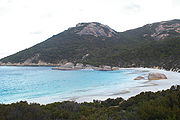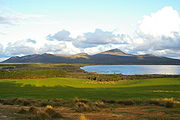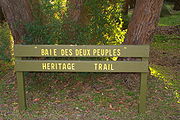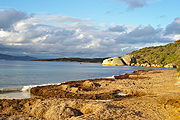
Two Peoples Bay Nature Reserve
Encyclopedia


Protected areas of Western Australia
Western Australia is the second largest subnational entity in the world. It contains no fewer than 1224 separate Protected Areas with a total area of 170,610 km²...
35 kilometres (22 mi) east of Albany
Albany, Western Australia
Albany is a port city in the Great Southern region of Western Australia, some 418 km SE of Perth, the state capital. As of 2009, Albany's population was estimated at 33,600, making it the 6th-largest city in the state....
. The area is accessible by 2WD vehicles. The bay itself, including two small secluded beaches, faces due east and is protected from the Southern Ocean
Southern Ocean
The Southern Ocean comprises the southernmost waters of the World Ocean, generally taken to be south of 60°S latitude and encircling Antarctica. It is usually regarded as the fourth-largest of the five principal oceanic divisions...
by a headland formed by the granite
Granite
Granite is a common and widely occurring type of intrusive, felsic, igneous rock. Granite usually has a medium- to coarse-grained texture. Occasionally some individual crystals are larger than the groundmass, in which case the texture is known as porphyritic. A granitic rock with a porphyritic...
massif
Massif
In geology, a massif is a section of a planet's crust that is demarcated by faults or flexures. In the movement of the crust, a massif tends to retain its internal structure while being displaced as a whole...
of Mount Gardiner. The nature reserve was established in 1967 to protect the threatened
Threatened species
Threatened species are any speciesg animals, plants, fungi, etc.) which are vulnerable to endangerment in the near future.The World Conservation Union is the foremost authority on threatened species, and treats threatened species not as a single category, but as a group of three categories,...
Noisy Scrub-bird
Noisy Scrub-bird
The Noisy Scrub-bird is a species of bird in the Atrichornithidae family. It is endemic to Australia.-Distribution and habitat:...
and its habitat.
History

Facilities
Two Peoples Bay boasts unspoilt coastal scenery and is a vital area for threatened animal species. There are beaches with path access that are suitable for swimming and snorkellingSnorkeling
Snorkeling is the practice of swimming on or through a body of water while equipped with a diving mask, a shaped tube called a snorkel, and usually swimfins. In cooler waters, a wetsuit may also be worn...
. Facilities within the reserve include a boat ramp, toilets and barbecues, however there is no drinking water available and visitors need to take their own. There is no entry fee for the reserve.
Plants

Eucalyptus
Eucalyptus is a diverse genus of flowering trees in the myrtle family, Myrtaceae. Members of the genus dominate the tree flora of Australia...
species including Coast Gum
Eucalyptus megacarpa
Eucalyptus megacarpa, Bullich, is a small to medium-sized tree of scattered distribution in the forests of the south-west of Western Australia. The bark is smooth, mottled grey, reddish-grey or white...
, Jarrah and Yate
Eucalyptus cornuta
Eucalyptus cornuta, commonly known as Yate, is a tree which occurs in an area between Busselton and Albany in Western Australia....
as well as other species such as Marri
Corymbia calophylla
Corymbia calophylla is a bloodwood native to Western Australia. Common names include Marri and Port Gregory Gum, and a long standing usage has been Red Gum due to the red gum effusions often found on trunks.It is distinctive among bloodwoods for its very large buds and fruit Corymbia calophylla...
and Juniper Myrtle
Taxandria juniperina
Taxandria juniperina commonly known as Wattle, Swamp Wattle, Warren River Cedar or Juniper Myrtle is a species of tree that grows in the south west corner of Western Australia. This plant was previously classified as Agonis juniperina but is now part of the Taxandria genus.- Description :T...
.
The understorey of the low forest includes species such as Swamp Banksia
Banksia littoralis
Banksia littoralis, commonly known as the Swamp Banksia, Swamp Oak, Pungura and the Western Swamp Banksia, is a tree in the plant genus Banksia. It is found in south west Western Australia from the south eastern metropolitan area of Perth to the Stirling Range and Albany...
, Pea-flowered Narrow-Leaved Water Bush and the Porungurup Wattle. Low woodlands in the broad valleys north of Moates Lake mainly consist of Albany Blackbutt and the area between Moates Lake and Gardiner Lake is mostly populated with Swamp Banksia
Banksia littoralis
Banksia littoralis, commonly known as the Swamp Banksia, Swamp Oak, Pungura and the Western Swamp Banksia, is a tree in the plant genus Banksia. It is found in south west Western Australia from the south eastern metropolitan area of Perth to the Stirling Range and Albany...
. A population of the threatened Granite Banksia
Banksia verticillata
Banksia verticillata, commonly known as Granite Banksia or Albany Banksia, is a species of shrub or tree of the genus Banksia in the Proteaceae family. It is native to the southwest of Western Australia and can reach up to 3 m in height. It can grow taller to 5 m in sheltered areas,...
has been eradicated by dieback
Dieback
Dieback may refer to a number of plant problems and diseases including:* Forest dieback caused by acid rain, heavy metal pollution, or imported pathogens* The death of regions of a plant or similar organism caused by physical damage, such as from pruning...
.
Animals
Two Peoples Bay is home to Australia's most threatened mammalMammal
Mammals are members of a class of air-breathing vertebrate animals characterised by the possession of endothermy, hair, three middle ear bones, and mammary glands functional in mothers with young...
and one of the rare
Rare species
A rare species is a group of organisms that are very uncommon or scarce. This designation may be applied to either a plant or animal taxon, and may be distinct from the term "endangered" or "threatened species" but not "extinct"....
st animals in the world, the Gilbert's Potoroo
Gilbert's Potoroo
Gilbert's Potoroo is an Australian marsupial, sometimes called a rat-kangaroo, that is critically endangered. It is described as pointed in the face and about the size of a rabbit. It lives in a restricted area on the southwest coast of Western Australia. Gilbert's Potoroos now exist on Bald...
(Potorous gilbertii). This potoroo
Potoroo
The Potoroo is a kangaroo/rat like animal about the size of a rabbit. All three extant species are threatened, especially The long-footed Potoroo and Gilbert's potoroo...
was though to be extinct until the population
Population
A population is all the organisms that both belong to the same group or species and live in the same geographical area. The area that is used to define a sexual population is such that inter-breeding is possible between any pair within the area and more probable than cross-breeding with individuals...
at Two Peoples Bay was discovered in 1994. It is estimated that there are fewer than 40 individuals left in the wild. Other threatened mammals in the area include the Southern Brown Bandicoot
Southern Brown Bandicoot
The Southern Brown Bandicoot , also known as the Quenda from the local Noongar tongue from South Western Australia, is a short-nosed bandicoot found mostly in southern Australia....
, Western Ringtail Possum
Western Ringtail Possum
The Western Ringtail Possum or Ngwayir is a possum found in Western Australia, regarded as a subspecies of Common Ringtail Possum, or as a separate species.-Description:...
, Australian Sea Lion
Australian Sea Lion
The Australian Sea Lion , also known as the Australian Sea-lion or Australian Sealion, is a species of sea lion that breeds only on the south and west coasts of Australia...
and the New Zealand Fur Seal
New Zealand Fur Seal
The Australian fur seal , or New Zealand fur seal or southern fur seal, is a species of fur seal found around the south coast of Australia, the coast of the South Island of New Zealand, and some of the small islands to the south and east of there...
. Quokka
Quokka
The Quokka , the only member of the genus Setonix, is a small macropod about the size of a domestic cat. Like other marsupials in the macropod family , the Quokka is herbivorous and mainly nocturnal...
s are also known to inhabit the park and Two Peoples Bay is though to be near the eastern limit of their range. Several reptile
Reptile
Reptiles are members of a class of air-breathing, ectothermic vertebrates which are characterized by laying shelled eggs , and having skin covered in scales and/or scutes. They are tetrapods, either having four limbs or being descended from four-limbed ancestors...
s can be found in the park including Little Brown Snake, Carpet Python
Carpet python
Morelia spilota is a large snake of the Pythonidae family found in Australia, Indonesia and New Guinea. There are 6 subspecies listed by ITIS, commonly referred to as Carpet and Diamond pythons.-Description:...
, Beautiful Skink and Mournful Skink.
Birds
The reserve forms part of the Two Peoples Bay and Mount Manypeaks Important Bird AreaTwo Peoples Bay and Mount Manypeaks Important Bird Area
The Two Peoples Bay and Mount Manypeaks Important Bird Area is a 261 km2 tract of coastal and subcoastal land east of the city of Albany in south-west Western Australia. It is an important site for the conservation of several rare and threatened birds....
, identified as such by BirdLife International
BirdLife International
BirdLife International is a global Partnership of conservation organisations that strives to conserve birds, their habitats and global biodiversity, working with people towards sustainability in the use of natural resources...
because of its significance in the conservation of several rare and threatened bird species. It supports a population of Noisy Scrub-birds, a species which was thought to be extinct until rediscovered in 1961. The population then was estimated at less than 100, while in 1994 it was thought to be around 1100 (of which 450 occur in the reserve). Other threatened birds inhabiting the reserve are the Western Ground Parrot
Western Ground Parrot
The Western Ground Parrot is an endangered species of parrot endemic to Western Australia and is a close relative of the Eastern Ground Parrot and the somewhat more distantly related and mysterious Night Parrot...
, Western Bristlebird
Western Bristlebird
The Western Bristlebird is a species of bird in the Dasyornithidae family.It is endemic to Australia.- Description :...
, Western Whipbird
Western Whipbird
The Western Whipbird is a passerine bird found in several scattered populations across southern Australia. It is predominantly olive green in colour....
and Australasian Bittern
Australasian Bittern
The Australasian Bittern , also known as the Brown Bittern, is found in south-western and south-eastern Australia, Tasmania, New Zealand, New Caledonia and Ouvea. Populations in Australia and New Zealand have declined in the 20th century.It is a large bittern, patterned and streaked brown, buff...
,
Other threatened bird species that have been observed within the park include Short-billed Black Cockatoo, Peregrine falcon
Peregrine Falcon
The Peregrine Falcon , also known as the Peregrine, and historically as the Duck Hawk in North America, is a widespread bird of prey in the family Falconidae. A large, crow-sized falcon, it has a blue-gray back, barred white underparts, and a black head and "moustache"...
, Hooded Plover
Hooded Plover
The Hooded Dotterel or Hooded Plover is a species of bird in the Charadriidae family. It is endemic to southern Australia and Tasmania. There are two recognized subspecies, both of which are classifed as Endangered....
, Little Bittern
Little Bittern
The Little Bittern is a wading bird in the heron family Ardeidae, native to the Old World, breeding in Africa, central and southern Europe, western and southern Asia, and Madagascar. Birds from temperate regions in Europe and western Asia are migratory, wintering in Africa and further south in...
and Red-eared Firetail
Red-eared Firetail
The Red-eared Firetail is a species of estrildid finch found in the forests and coastal thickets of south-western Australia. It has an estimated global extent of occurrence of 20,000 - 50,000 km². The status of the species is evaluated as Least Concern.-References:...
. Seabird
Seabird
Seabirds are birds that have adapted to life within the marine environment. While seabirds vary greatly in lifestyle, behaviour and physiology, they often exhibit striking convergent evolution, as the same environmental problems and feeding niches have resulted in similar adaptations...
s nesting on the islands around the bay include the Great-winged Petrel
Great-winged Petrel
The Great-winged Petrel or Grey-faced Petrel, Pterodroma macroptera, is a petrel. In New Zealand it is also known by its Māori name oi and as a muttonbird.- Taxonomy :...
and Flesh-footed Shearwater
Flesh-footed Shearwater
The Flesh-footed Shearwater, Puffinus carneipes, is a small shearwater. Its plumage is black. It has pale pinkish feet, and a pale bill with a black tip. Together with the equally light-billed Pink-footed Shearwater, it forms the Hemipuffinus group, a superspecies which may or may not have an...
.
Geographic features
The total area enclosed by the nature reserve is 4744.7 hectares (11,724 acre). It consists of three separate areas:- A section of 4510 hectares (11,144 acre) that contains Mount Gardner, Lake Gardner, Moates Lake, rocky shoreline of Sinkers ReefReefIn nautical terminology, a reef is a rock, sandbar, or other feature lying beneath the surface of the water ....
, graniteGraniteGranite is a common and widely occurring type of intrusive, felsic, igneous rock. Granite usually has a medium- to coarse-grained texture. Occasionally some individual crystals are larger than the groundmass, in which case the texture is known as porphyritic. A granitic rock with a porphyritic...
headlands, secluded sandy beaches such as Little Beach and Waterfall Beach and mobile dunes - A smaller section of 89 hectares (220 acre) that is about 2 kilometres (1 mi) north of the main area that includes the northern portion of Angove lakeAngove LakeAngove Lake is a permanent freshwater lake in the Great Southern area of Western Australia.-Description:The lake is part of the Moates Lake System along with Moates Lake and Lake Gardner...
and the Angove RiverAngove RiverAngove River or Angove Creek is a river located in the Great Southern region of Western Australia most of the river is found within Two Peoples Bay Nature Reserve.... - Four islands - Coffin IslandCoffin IslandCoffin Island is an island that is located in the Great Southern region of Western Australia. The island is offshore from Two Peoples Bay Nature Reserve and the island is also a protected area making up part of the reserve....
, Black Rock, Inner Island and Rock Dunder

